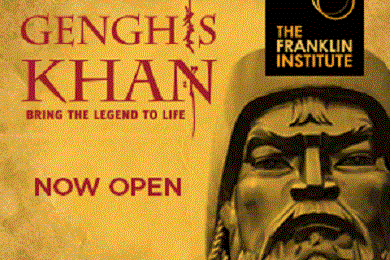Mongolians call him “Chinggis,” erect massive statues in his honor, and affix his name and image to everything from currency and playing cards to beer bottles and bath mats. In his native land, Genghis Khan (1162-1227), famed for his murderous Mongolian hordes, has been both domesticated and deified, serving as a symbol of power, strength, order and resurgent nationalism.

A traveling exhibition, “Genghis Khan: Bring the Legend to Life” at the Franklin Institute, which runs until Jan. 3, 2016, seeks to convey some of Genghis’s complexity. Organized by Don Lessem, a local dinosaur expert and frequent visitor to Mongolia, it stresses that Genghis’s empire incorporated such modern features as religious freedom, a system of laws, passports, diplomatic immunity and meritocracy.
But those innovations left behind relatively few artifacts. One exception, featured in the exhibition, is a cast of a 13th or 14th century iron and silver passport medallion issued by Kublai Khan (1215-1294), one of Genghis’s grandsons, or a successor. Loosely translated, the inscription, conveying both authority and brutality, reads: “I am the emissary of the Khan. If you defy me, you die.”
After Genghis’s death, most likely from disease or injuries from falling off a horse, his often-feuding sons and grandsons extended Mongolian hegemony from Vienna to the Pacific Ocean. They created the largest contiguous land empire in history before infighting, rebellion, invasion and the bubonic plague shattered it. An animated floor map demonstrates the Mongols’ stunning accretion of land over time.
We learn that the Mongols’ elaborately curved bows, flexible armor, deceptive military tactics and equestrian prowess fueled their victories. And that they didn’t shy away from slaughtering innocents—or banqueting on top of a box in which Russian noblemen were suffocating. Terror was a weapon; Genghis fostered his horrific reputation to inspire submission. (“I am the punishment of God,” he is alleged—probably apocryphally—to have said.) The violent image turns out to be indelible.
More problematic is the juxtaposition of artifacts from different periods, ranging from more than a millennium before Genghis Khan to the near-contemporary. This may be justified, in part, by the persistence of customs and styles—many Mongolians still live in yurts, rely on horses and practice shamanism—but it does blur distinctions between Genghis’s time and later eras.
Before he was Genghis, the Mongol leader was Temüjin, an outcast whose father was poisoned by a rival clan leader and whose mother struggled to raise a brood of children on her own. As a teenager, along with a brother, he murdered his older half-brother, who was a bully and a food thief. Later, he rescued his bride-to-be, Börte, who had been kidnapped. (Her story—along with those of other characters, real and fictional—is told by family-friendly interactive stations.)
In the 1230s, Genghis’s third son and principal successor, Ögedei, expanded an outpost in Western Mongolia into a walled capital, Karakorum, which became a center for music and crafts. Genghis’s grandson Kublai Khan, immortalized by Samuel Taylor Coleridge’s poem (“In Xanadu did Kubla Khan / A stately pleasure-dome decree”), conquered China, founded the Yuan Dynasty and welcomed the Venetian merchant Marco Polo.
A final gallery briefly covers the image of Genghis in popular culture, including such Hollywood productions as “The Conqueror” (1956), improbably starring John Wayne, and “Star Trek II: The Wrath of Khan” (1982), whose villain was inspired by the Mongolian warrior. It also offers the tantalizing suggestion that Genghis, thanks to all those wives and concubines, may have 16 million living descendants, most in the former Mongol territories. “We went with the most conservative estimate,” Mr. Lessem said.
A scientist in a video says the estimate derives from two sources: genetic data on the persistence of a distinctive Y chromosome passed from father to son and (unexplained) historical research. (The impressive exhibition catalog, “Genghis Khan and the Mongol Empire,” details the genetics.) Whether reliable or not, the figure—like this exhibition—helps advance the Mongolian project to reclaim Genghis’s checkered legacy.
Author: Julia M. Klein | Source: The Wall Street Journal [July 16, 2015]
VIA «'Genghis Khan: Bring the Legend to Life' at the Franklin Institute»





